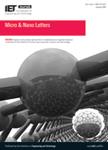版权所有:内蒙古大学图书馆 技术提供:维普资讯• 智图
内蒙古自治区呼和浩特市赛罕区大学西街235号 邮编: 010021

作者机构:CSIR Inst Genom & Integrat Biol Mathura Rd New Delhi India CSIR Inst Genom & Integrat Biol Mall Rd Delhi India Univ Meerut CCS Dept Biotechnol Meerut Uttar Pradesh India
出 版 物:《MICRO & NANO LETTERS》 (Micro. Nano. Lett.)
年 卷 期:2017年第12卷第10期
页 面:799-802页
核心收录:
基 金:CSIR Network Project [BSC0302]
主 题:nanoparticles carbon nanofabrication nanomedicine antibacterial activity biomedical materials microorganisms dentistry drugs ultraviolet spectra light scattering transmission electron microscopy blood toxicology cellular biophysics antimicrobial efficiency minimum inhibitory concentration microbial killing potential hemolysis assay toxicity human cells cell viability MRC-5 cell line C antibiotic resistant bacteria cavity-free patients post cavity dental cavity isolated oral bacteria antibiotic sensitivity test transmission electron microscopy dynamic light scattering UV spectroscopy clay pots burning mustard oil green synthesis nanotised form charcoal powder plaque removal tartar drug formulations bacteria degradation teeth surface plaque accumulation dental infections dental caries antibacterial activity carbon nanoparticles
摘 要:Dental infections are thorny since time immemorial mainly due to the accumulation of plaque on the teeth surface. Antibiotics are slowly losing their capability to degrade bacteria due to development of resistance in them which necessitates the need of new drug formulations. The role of carbon for tartar and plaque removal in the form of charcoal powder is seen for ages. Hence, in this study, nanotised form of carbon has been exploited for their role against resistant bacteria. Green synthesis of carbon nanoparticles (CNPs) was accomplished from the soot of the burning mustard oil which was collected on clay pots. The synthesised particles were characterised by UV spectroscopy, dynamic light scattering and transmission electron microscopy. Antibiotic sensitivity test of the isolated oral bacteria from dental cavity, post cavity and cavity-free patients was done in order to find out the antibiotic resistant bacteria. Antimicrobial efficiency (minimum inhibitory concentration) of CNPs was carried out on these antibiotic resistant bacteria and observed their microbial killing potential. Hemolysis assay was conducted to comprehend the toxicity of these nanoparticles on human cells. Cell viability study on MRC-5 cell line showed that nanoparticles are safe to use.